Navigating behavior challenges with your Great Dane can feel like a big puzzle to solve! When it comes to training, our beloved dogs might seem like they have a mind of their own. Tackling Great Dane behavior problems like pulling, enthusiastic barking, and acrobatic fence-jumping can be an adventure for owners of these lovable behemoths.
But fear not! While the challenges may seem big, the rewards of overcoming them are even bigger. Let’s journey together to better understand and address the quirks that come with our colossal canine companions, turning potential problems into valuable lessons and shared laughs.
If you are having trouble with your Great Dane or Great Dane puppy, don’t worry – you are not alone!

#1 – My Great Dane Won’t Come When Called
Poor recall is one of the #1 complaints that Great Dane dog owners have about their dog’s behavior!
There are a few things that you can do to improve your dog’s recall and ensure they are a well-behaved off-leash citizen:
- Use a long line or leash when first teaching your dog to come
- Prevent mistakes! If your dog doesn’t come to you, they shouldn’t be off-leash
- Make sure you are calling your dog to you in an excited and happy voice, and NEVER correct your dog for ignoring you.
- Reward with high-value treats, praise, play, and affection
- Practice in boring areas!
Recall games for Great Danes
These are some of our favorite Great Dane recall games for teaching rock-solid off-leash coming when called behavior!
- The Amped Up Recall game: Have somebody hold your Great Dane by their chest or collar. While they are being held, RUN away from them and be super fun. Wave a toy around, whoop, holler, and be exciting! When you are several feet away, turn and say ‘COME!’ and then have the other person release your Great Dane. Your dog will RUN to you (proving that dogs will come to people who are worth coming to). Play this game often.
- The slot machine jackpot recall game: Practice recall with high-value treats. Think of yourself like a slot machine. Sometimes, you give one treat. Sometimes you give 3 to 5 treats. Occasionally, you give a JACKPOT! The best jackpots will be a complete surprise and something even higher-value than what has been offered before.
- The follow-me game: give your Great Dane a reward for looking at you. Turn your back. When your Great Dane comes to look at you, give another reward. Turn your back and walk a step. Reward again when your dog looks at you. This is a FUN game that involves you eventually being able to turn, walk farther away, zig-zag, and even hide behind things.
Your Great Dane should always WANT to come and find you!
Once your Great Dane has a rock-solid recall in low distraction areas (such as your backyard or on a long leash on a soccer field), it’s time to layer in an E-Collar so you can ditch the leash in places where doing so is safe and legal!
Using an E-Collar to Improve Recall
E-Collars are NOT a magic fix for poor recall! If your Great Dane doesn’t have a good recall in a low distraction area, do not expect an E-Collar to fix the problem.
An E-Collar can replace your long-leash, so that your Great Dane can zoomie, run, climb, swim, sniff, explore, and move naturally. There is nothing more positive than that!
Most Great Danes will benefit greatly from being allowed to exhibit these correct and species-appropriate behaviors.
Sniffing the ground on a long leash is NOT enough!
E-Collars are NOT the same as shock collars. The method, science, concepts, and sensation are completely different.
An E-Collar uses muscle stimulation that is non-aversive and works the same way that your cell phone does.
Your cell phone ringing does not hurt you, punish you, or scare you BUT it does make you take action. This is how modern E-Collars work for coming when called.
By replacing the feeling of a harness, collar, and pressure from a leash with virtual pressure, our Great Danes can be safely off-leash. This is especially true once they are trained to also ignore dogs and people.
Many Great Danes who are reactive towards dogs and people on a leash will be completely non-reactive when e-collar trained.
The truth is that leashes are restrictive and cause anxiety for many dogs.
E-Collars allow dogs to move naturally and because they are no longer ‘trapped’, they feel safe.
Another major plus about E-Collars is that they are the ONLY tool that uses no physical restraint. For giant breed dogs like Great Danes, this is an incredible benefit to their orthopedic health.
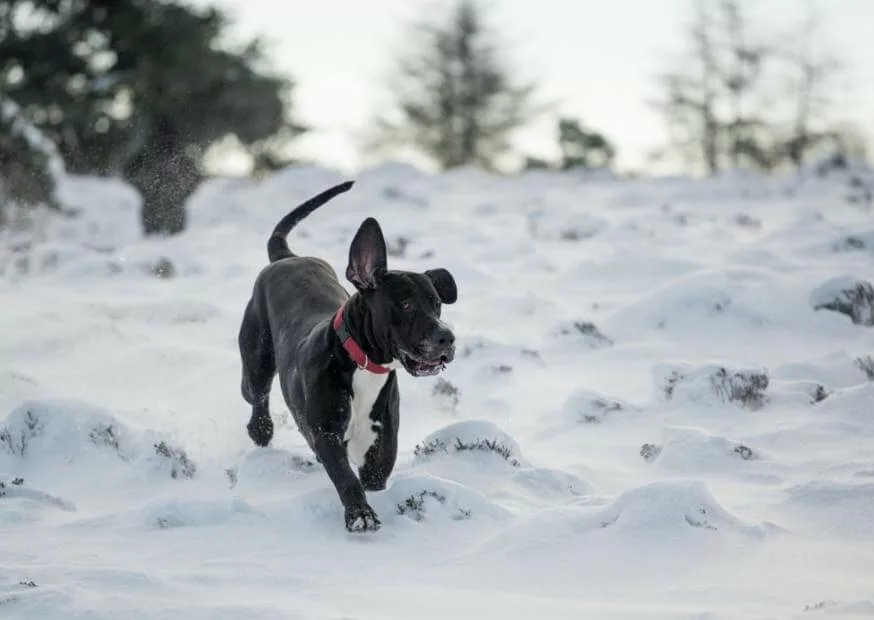
#2-How do I stop my Great Dane from Counter Surfing?
This is a hard one because it’s a natural thing for dogs to do! After all, counters are full of yummy smells and things to investigate.
The best way to stop your Great Dane dog from counter surfing is to make the counter a place they cannot access.
If this isn’t possible or practical, you’ll need to be diligent about teaching your dog that the counter is off-limits.
The easiest way to do this is to use a cue like “leave it” or “off”. As soon as your Great Dane jumps on the counter, say the cue and give them a treat for getting down.
Because counter surfing is also a very dangerous behavior (for example, if they were to get grapes or cooked chicken bones), it’s a behavior we feel very comfortable advising corrections on.
It must NEVER be acceptable for your Great Dane to steal food from the counter!
These corrections can include a sharp NO, ‘AH-AH’, clapping your hands, stomping the floor, leash pops, or even sticky tape on the counter (which sticks to their paws).
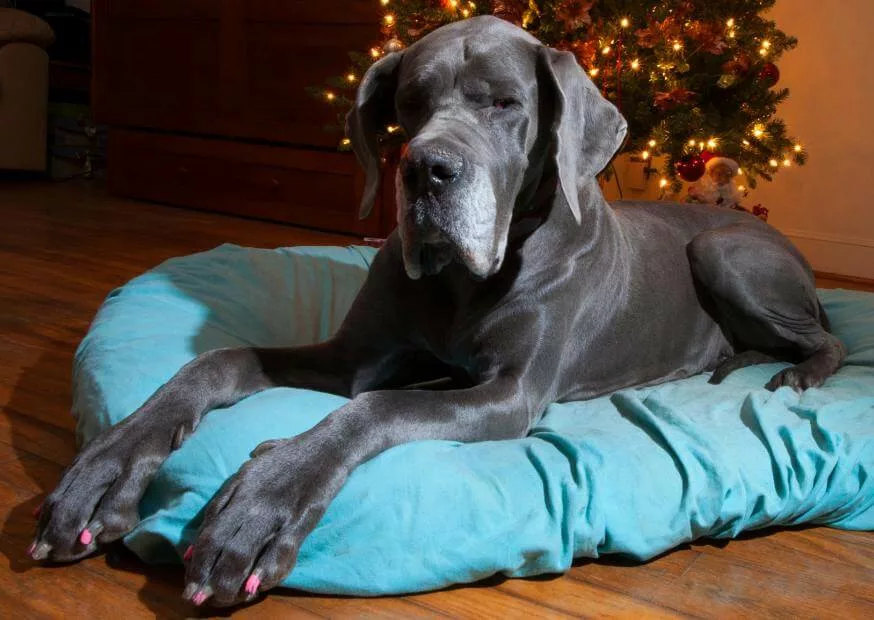
#3 – How do I stop my Great Dane from Pulling?
Leash pulling is a common and dangerous problem with Great Danes that may require professional help. Most Danes pull because doing so is fun and rewarding, and gets them where they want to go.
Read here for why we do NOT recommend the use of Halti Head Collars or Gentle Leader type tools!
To address leash pulling in Great Danes, we recommend the following:
- Teach focus, engagement, and a loose-heel position indoors, off-leash.
- Start small and use a lot of rewards!
- As your Great Dane understands this fun game, start adding distance and zig-zags.
- Clip a leash to a wide, flat martingale collar and continue this game of checking in, watching, engaging, and walking next to you with rewards and praise.
- Once your Great Dane is able to do this next to you in a low distraction environment, we recommend layering in a Herm Sprenger prong collar.
- Teach your Great Dane that gentle pressure from the collar (which does not stab or pinch!) means to turn and engage with you. Reward this behavior with praise and rewards
Prong Collar Training
Here is a great video on how to properly introduce a prong collar to your Great Dane!
#4 – My Great Dane Keeps Digging Holes
It can be a huge problem if your Great Dane digs holes! Not only does this make a mess of your beautiful yard, but then they are dragging mud, dirt, and all the parasites that come with it into your home.
Mud and digging, in general, are actually very good for dogs! It’s natural for them to want to dig and it’s a great way for your Great Dane dog to relieve boredom, stress, and pent-up energy.
The key is to provide your Great Dane with an appropriate outlet for this behavior. If they are left alone with nothing to do, of course, they are going to take it out on your lawn! Many behavioral problems are actually the result of plain old boredom.
You can teach your Great Dane to only dig in one area of the yard by using positive reinforcement and being consistent with redirection.
If the digging absolutely must stop, you need to replace it with another form of enrichment. Off-leash exploration, puzzle toys, and scent tracking are fantastic substitutes.
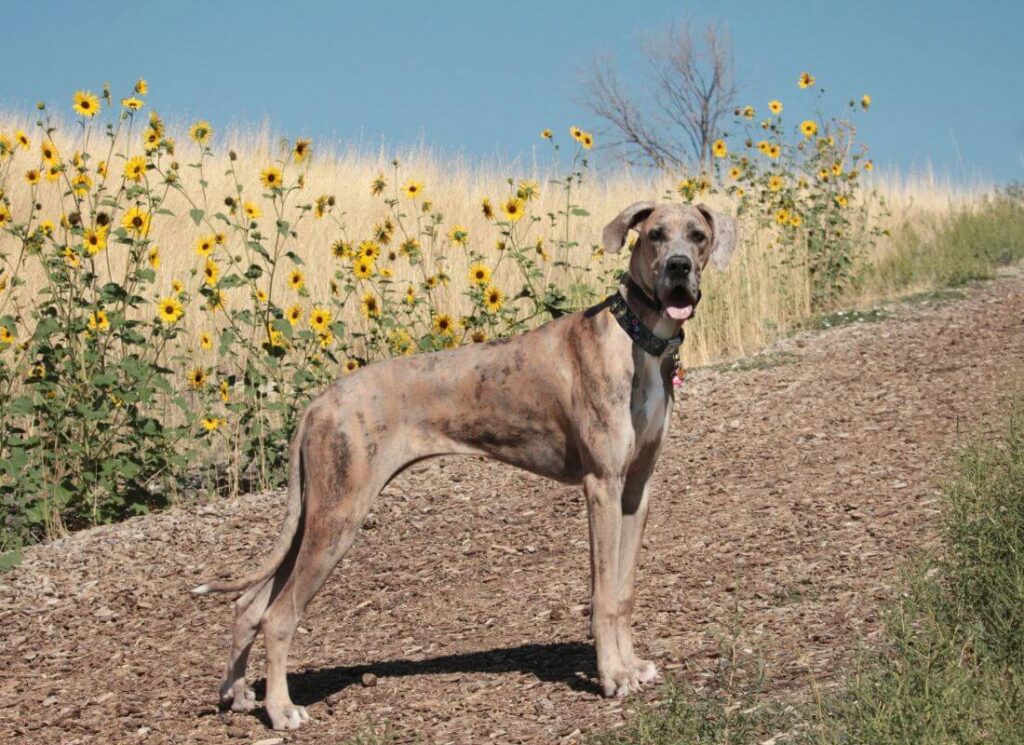
#5-My Great Dane is Destroying My House
You know what they say, right? If you don’t give your Great Dane a job to do, they will give themselves a job. You will NOT like their choice of employment!
Bored and anxious Great Danes will destroy your house. Literally.
It’s not uncommon for us to hear from frantic Great Dane owners whose dog has just eaten an entire couch, destroyed drywall, or chewed through electrical wires.
The good news is that this behavior is 100% preventable with crate training, the right amount of exercise, mental stimulation, and training.
Step one requires that you prevent this behavior. Crate training 101 is a fantastic place to start!
Following that, a drastic increase in positive training and daily enrichment will make a huge difference.
Here are some ideas:
- Work on AKC trick titles
- Work on Canine Good Citizen test items
- Feed all meals in puzzles
- Practice the ‘place’ command
- Daily off-leash exploration (we recommend E-Collar training)
- Hide and seek
- Scent work games
- Gentle exercise such as playing seek games or FitPaws
- Socialize and train in a new environment: the brewery, a public park, or if your dog is confident and trained, a dog-friendly store such as Petsmart or Home Depot (call in advance to confirm)
What can I do to Stop Separation Anxiety?
Unfortunately, many Great Danes suffer from separation anxiety.
This can manifest in a number of ways, such as destructive behaviors, excessive barking or howling, pacing, panting, and more.
The key to helping your dog with separation anxiety is to make sure that they ultimately feel safe when they can’t see you.
This can mean addressing the anxiety from multiple angles, not just when you are away! Exercise, obedience, puzzles, and trick training sessions are great confidence builders for Great Danes.
You can also help build your dog’s confidence by exposing them to short periods of time away from you, and by teaching them that good things happen when you leave.
For some dogs, this may mean starting with only a 30-second gap and working up from there. For others, it may mean building up to longer periods of time by using a dog sitter or daycare.
The most important thing is to go at your dog’s pace and not to push them too hard, too fast. If you do, you will only end up making the anxiety worse.
It will be helpful to use a Kong stuffed with their favorite treats, or to buy a puzzle toy such as the Kong Wobbler.
The FURBO camera is another great way to interact with your Great Dane when you are not home, as it allows you to talk to them, see them, and give them a treat, all virtually!
You can also help your dog feel more secure by providing them with a lot of novel enrichment and training.

#6-How can I Stop my Great Dane from Jumping?
Jumping is a dangerous behavior that requires proper training from a young age, if possible. If you want your Great Dane to be a great family dog and be gentle around other dogs, the jumping must be addressed.
While I tend to be fairly positive in how I train my dogs, I will admit that I have absolutely had a moment with giant puppies that jumped.
My 5-month-old male Great Dane puppy caught me off guard one day, jumped up, and scraped my eye with his huge paw. Without even thinking I stepped into him and then shouted at him with a very loud, sharp tone.
I felt so bad after that, but it was a gut reaction. Thankfully, he’s never done it again! I can’t deny that this worked. However, it’s not the recommended approach for a number of reasons.
To correctly address this behavior, you need two pieces:
Reinforce good behavior with attention, praise, treats, and play. When working with an excitable puppy, calmness is key. It’s a great idea to have high-value treats on hand to reward your Great Dane pup.
Redirect attention away from the jumping and towards something else, such as sitting or lying down. This can be done with a cue such as ‘sit’ or ‘down’.
The second piece involves correcting the behavior. If teaching the alternate behavior isn’t enough, it’s fair to then implement a correction.
No-jump corrections might look like this, depending on the individual dog. Adult Great Danes will take more work, as they have already established a bad habit.
- Turn your back and walk away (jumping = loss of attention)
- Sharp leash pop, followed by reward when the Great Dane has all paws on the floor
- Saying ‘uh-oh’ and removing your leashed dog to another room when they jump
- Walking into the dog when they jump up
We do not recommend using physical force or shoving your dog with a knee or a hand. Not only can this be damaging, but it’s also very confusing!
Some dogs see this gesture as a form of roughhousing and will become more excited and jumpy.
Many dog owners find that working with a dog trainer helps them learn more about the timing of rewards and corrections, so that everybody can move on from it!
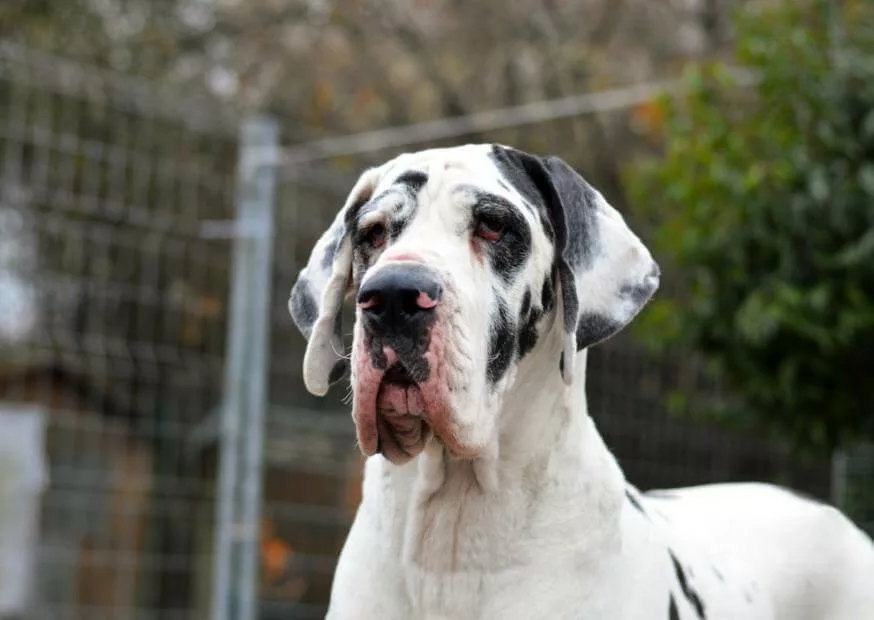
#7-My Great Dane Growls Over Food & Toys
Resource guarding is normal behavior that can be seen in any animal, including humans. It’s when an animal or even a puppy feels the need to protect a valuable resource, such as food, toys, or even you!
Dogs who guard resources may do so because they feel like they don’t have enough, or because they are afraid of losing what they have. It has nothing to do with dominance. It can be, however, genetic.
Resource guarding is a dangerous behavior, especially for a Great Dane!
Many cases of resource guarding are made worse by humans who unfairly fuss, punish, correct and take things from their dogs to ‘teach them who is boss’.
The best way to address resource guarding is with behavior modification and training, instead. This can be a long process, but it’s worth it to have a dog who feels confident around you and isn’t afraid of losing its things.
We recommend the book MINE by Jean Donaldson, and seek a professional trainer’s advice if you have a Great Dane that is resource guarding.
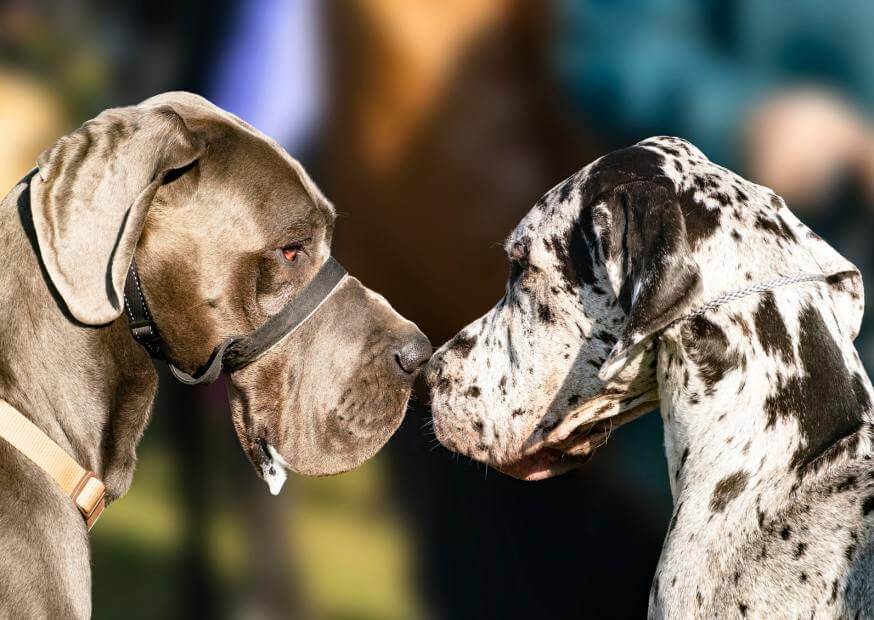
#8 – My Great Dane is Reactive
Reactivity is different than aggression. A reactive dog is one that over-stimulates easily and has a low threshold for arousal.
This can be due to genetics, environment, poor socialization, frustration, anxiety, or a combination of several factors.
Dogs who are reactive may lunge, bark, growl, snap, or bite when they feel overwhelmed. Other forms of reactivity include whining, fussing, and rolling over (often mistaken as ‘submission’).
It’s important to remember that these behaviors don’t necessarily mean that your Great Dane is aggressive and wishes to harm!
Lower arousal and frustration levels with thoughtful management, desensitize and counter-condition to trigger stimuli, provide outlets for your dog’s energy, and seek professional help if needed.
A great resource for fearful reactive dogs is the book The Cautious Canine by Dr. Patricia McConnell.
Reactivity vs. Protectiveness in Great Danes
Many people believe that their Great Dane is being protective when really, their Great Dane is being reactive.
Reactive dogs can easily go over the threshold and will struggle to focus, listen, or settle. These dogs are insecure and are protecting themselves, not necessarily the home or the people.
Protective dogs, on the other hand, will alert, but can quickly become calm and confident on command, welcoming people into the home.
How do I Help my Aggressive Great Dane
Having an aggressive Great Dane dog can be frustrating and heartbreaking. It requires dedication, resources, and time that many owners just don’t have.
Many rescues cannot accept aggressive dogs because it requires them to have strict protocols, highly trained volunteers, and enhanced insurance coverage.
The different types of aggression
There are two types of aggression, passive and active.
Passive aggression is characterized by a dog who is growling, baring its teeth, or stiffening its body in order to make itself look bigger. This type of aggression is often seen in dogs who are guarding something, such as food or a toy.
Active aggression is characterized by biting or snapping. This type of aggression is dangerous and can result in injuries.
If a dog is willing to injure you or another dog, they are a liability and will require professional training to address behavioral problems and aggressive tendencies.
Great Dane aggression can be caused by a number of things, including:
- Fear
- Anxiety
- Health problems, including thyroid disorders, UTI, pain, cancer, or otherwise, which can cause sudden aggression for no apparent reason
- Painful orthopedic conditions
- Genetics
- Neurological disorders
Fear aggression is the most common type of aggression in Great Danes. For normally gentle dogs that become suddenly aggressive, a thorough veterinary check is warranted to rule out health problems.
Giant breeds should never display aggressive behaviors, and if they do, they are more dangerous than a small dog might be. This breed has large, powerful jaws and most Great Danes are stronger than many humans.
Contrary to popular belief, Great Danes are not supposed to be an aggressive breed. They are friendly dogs that make excellent family members.
Aggressive behavior always has an underlying root cause that must be addressed.
How to manage Great Dane aggression
Because Great Danes are such big dogs, it’s important that you manage aggression and prevent injury.
Crate training and muzzle training are important steps you can take toward keeping your Great Dane and others safe!
Do not expose your aggressive Great Dane dog to situations that trigger reactions, especially if your dog is explosive and making contact with his teeth.
Aggressive behavior is embarrassing and dangerous. This means no doggy parks, off-leash hiking, or other socialization opportunities.
You’ll need to provide plenty of structure and rules for your Great Dane so that he knows what is expected of him. This may include crate training, obedience training, and positive behavior modification.
Avoid using physical force and harsh handling on your Great Dane, which can make aggression worse. We recommend reaching out to an IABC Accredited dog trainer or a board-certified Veterinary Behaviorist.
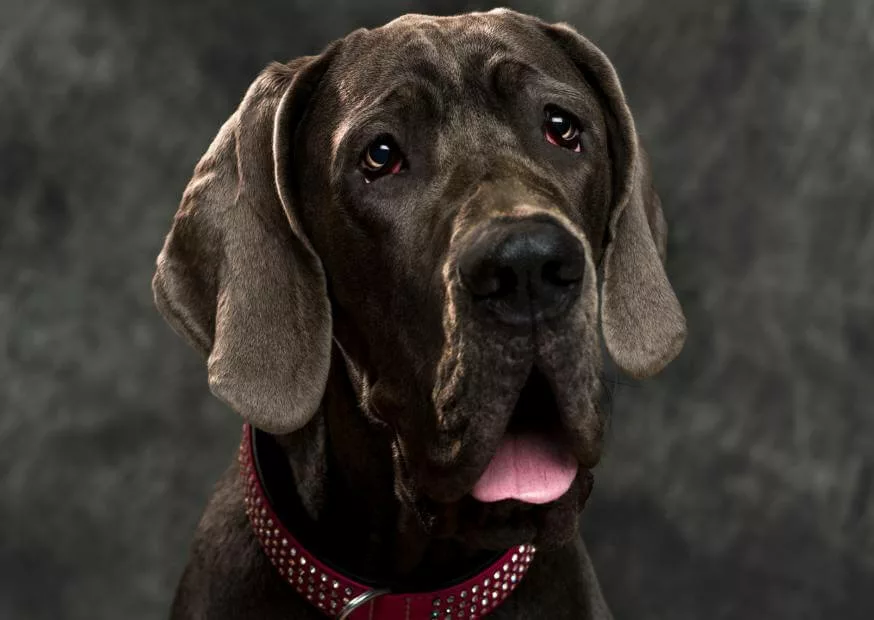
A touchy subject: behavioral euthanasia
Sometimes Great Danes just aren’t able to cope with the world, and they will respond with aggression to protect themselves.
Occasionally, tough decisions have to be made.
Behavioral euthanasia is reserved for Great Danes who experience significant and dangerous levels of aggression, reactivity, and fear that are not helped with training, behavior modification, management, and medication.
For some Great Danes and some owners, this is truly the most humane choice. It should not be taken lightly, nor should it be harshly judged. Most veterinarians will not euthanize healthy dogs.
A dog that is severely aggressive is likely suffering.
What causes Great Dane Behavior Problems?
If your Great Dane is out of control, many factors may be at play.
It rarely if ever has to do with ‘dominance’ or ‘stubborn’ behavior!
Here are some common causes of behavioral problems in Great Danes, plus information on correcting them.
Weak genetics
Temperament and behavior have a strong relationship to genetics.
If your dog’s parents were timid, snappy, unpredictable, anxious, pushy, fearful, or aggressive there is a good chance that your Great Dane will inherit some of those traits.
The final temperament and personality of a puppy is influenced by many factors, but this is perhaps the most important one.
Ideally, a Great Dane puppy should be friendly, social, and confident.
Poor socialization
Good breeders begin socialization at 3 days of age, through programs called ENS and Puppy Culture. If a breeder isn’t doing these things with their litter of Great Dane puppies, they may not be as dedicated or diligent as they should be.
Once your Great Dane puppy is home, the rest is up to you!
Poorly socialized dogs are more prone to anxiety, fearfulness, and aggression. Anxiety in Great Danes can be difficult to deal with and should be addressed as young as possible.
It’s important to start teaching and socialization on day one. Reward good behavior, confidence, and engagement with you with treats, praise, play, and fun!
Socialization should be positive and include exposure to a variety of sights, sounds, textures, experiences, things, and people.
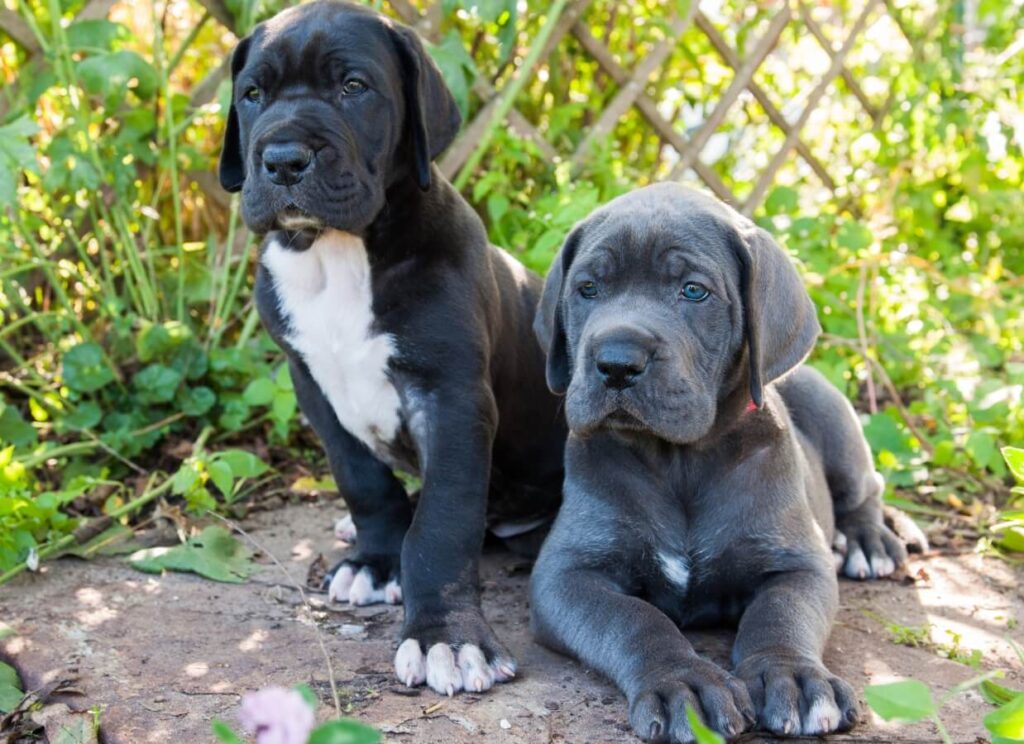
Inadequate Enrichment & Exercise
Great Danes can have a surprising amount of energy – they were originally bred as hunting dogs, after all!
If you don’t give your Great Dane enough outlets for their energy, they may become destructive or even aggressive.
A short walk on pavement, a few toys, another dog, and a yard are rarely enough, especially for Danes that are left home all day.
We recommend that Great Danes receive plenty of off-leash time to move freely on varied terrain, in addition to basic obedience, scent work, and food puzzles to keep their mind busy.
Bad training methods and techniques
Unfortunately, bad techniques can actually cause and worsen behavior problems such as aggressive behavior, destruction, reactivity, and anxiety.
These things include:
- Harsh punishment
- Alpha/Dominance, including intimidation and ‘pack leader’
- Forceful and punitive use of training tools of any kind
- Restrictive methods that rely heavily on physical restraint, isolation, and constant micro-management
- A lack of consistency and boundaries
- Expecting too much
- Not using enough positive reinforcement
- Failure to address medical problems
When looking for a dog trainer for your Great Dane or Great Dane puppy, ask them three questions:
a. Are you licensed and insured? Do you have any certifications?
b. What do you do when my dog does something right?
c. What do you do when my dog does something wrong?
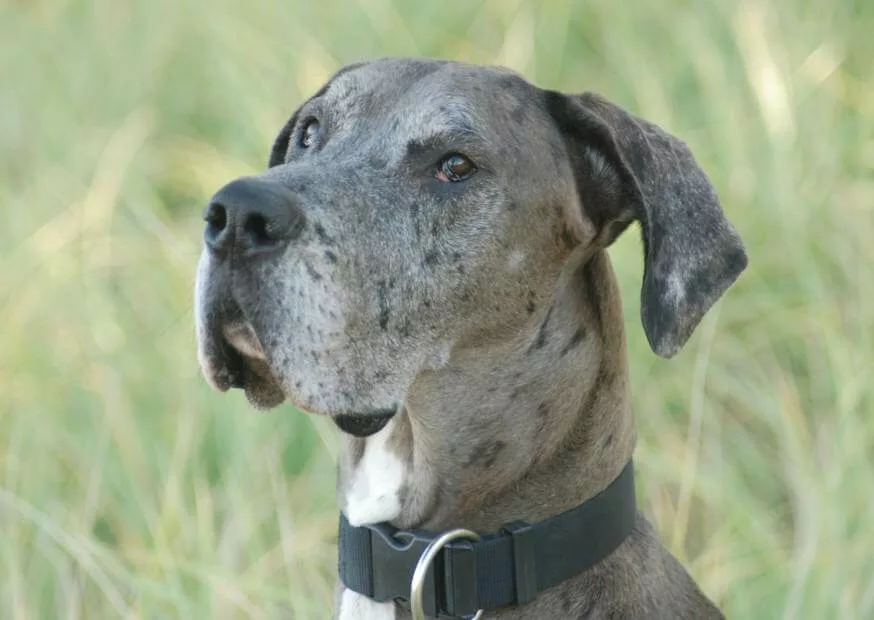
What is the Best Method for Training Great Danes?
The best method for training Great Danes is one that uses a lot of positivity and fun and is based on a strong foundation of trust, respect, and teamwork.
A thoughtful training program that includes a lot of YES with rewards paired with the occasional NO is incredibly effective.
We advocate for the use of positive reinforcement paired with modern tools such as E-Collars and prong collars.
Giant breed dogs should be diligently trained and socialized for their safety and the safety of those around them. They are never fully trained, though! Great Dane training should be ongoing, for life.
An out-of-control Great Dane dog wearing a harness or refusing to come when called is a dangerous animal.
Ideally, Great Dane puppies start training as soon as possible. But it’s never too late!
Great Danes make wonderful family pets for people who are willing to put the time into teaching, guiding, rewarding, and building a relationship with them.
We recommend working with a professional trainer, even if you think you know everything! There is always something new to learn, especially when it comes to handling large dogs.
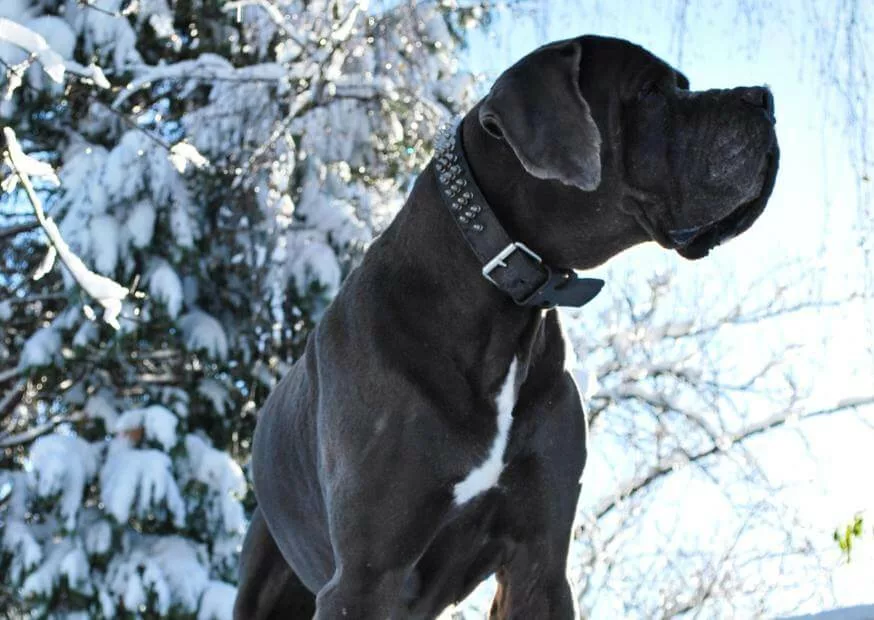
Balanced Training vs. Positive Training
“Positive only” training relies heavily on behavioral management to prevent bad behavior, which can be frustrating to dogs and owners.
Management includes the use of physical restraint, crates, gates, and isolation from experiences, people, and dogs while a dog is learning without error. The goal with ‘positive’ or ‘force-free’ training is to never have to say ‘no’.
The ‘force-free’ method markets front-clip harnesses and head collars as ‘gentle’. We find these tools to be aversive, punishing, and potentially damaging to Great Danes orthopedic health.
We believe that modern balanced training is the most humane, fun, and positive way to train your gentle giants!
All exceptional “balanced” trainers use a lot of positive reinforcement and avoid harsh punishments, intimidation, pain, and fear. Balanced training is positive training with a more holistic approach to correcting dangerous or incorrect behaviors.
You should never see your Danes tail tucked, ears back, or lip licking during training; these are behaviors that are associated with fear, frustration, and anxiety.

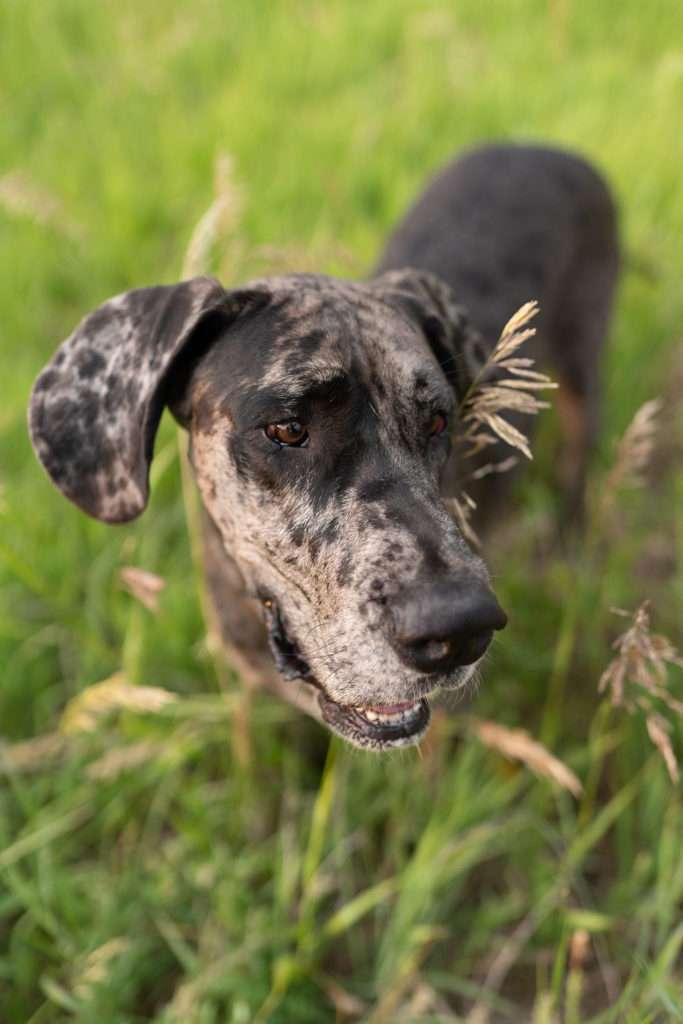



2 Responses
Can you tell me why my 3 year old great Dane suddenly attacked our 4 year old Great Dane that he ate, slept, played with 24 hours a day and basically loved beyond belief just hours before the attack. They live with us in a home that offers inside and outside (via doggy doors) access. One of us is home most of the time. We were not at home at the time of the attack, they were outside.
We are heart broken.
I’m so sorry to hear this happened 🙁
I would look back at their history – has there ever been any sign of tension over food, beds, treats, toys, etc.? Tension could be as mild as ears being pinned back, stiffness, etc.
The next step would be to visit the veterinarian. There are a number of painful, internal, and neurological problems that can result in behavioral changes, and both dogs need to be checked out for everything from cancer to heart disease, arthritis, vision, etc. The veterinarian may also refer you to a veterinary behaviorist.
You did nothing wrong, it sounds like your dogs are very loved and cared for. Sometimes these things pop up, and we have to look at small things that are out of our control, that may have contributed. In the meanwhile, I would keep them apart until you can get some more information from professionals who can see them in person. Keep us posted!